Welcome to the statistics and probability page at Math-Drills.com where there is a 100% chance of learning something! This page includes Statistics worksheets including collecting and organizing data, measures of central tendency (mean, median, mode and range) and probability.
Students spend their lives collecting, organizing, and analyzing data, so why not teach them a few skills to help them on their way. Data management is probably best done on authentic tasks that will engage students in their own learning. They can collect their own data on topics that interest them. For example, have you ever wondered if everyone shares the same taste in music as you? Perhaps a survey, a couple of graphs and a few analysis sentences will give you an idea.
Statistics has applications in many different fields of study. Budding scientists, stock market brokers, marketing geniuses, and many other pursuits will involve managing data on a daily basis. Teaching students critical thinking skills related to analyzing data they are presented will enable them to make crucial and informed decisions throughout their lives.
Probability is a topic in math that crosses over to several other skills such as decimals, percents, multiplication, division, fractions, etc. Probability worksheets will help students to practice all of these skills with a chance of success!
Most Popular Statistics and Probability Worksheets this Week
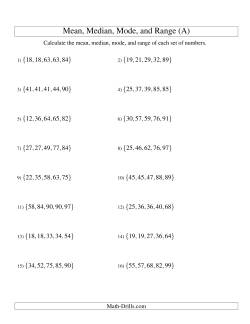
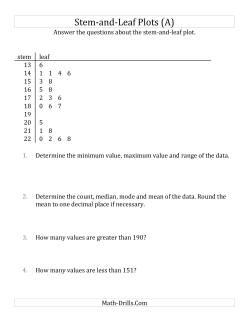
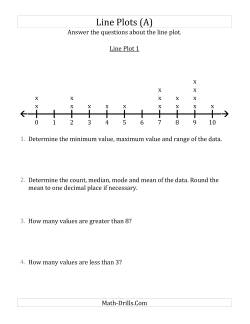
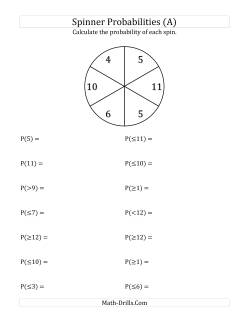

Mean, Median, Mode and Range Worksheets
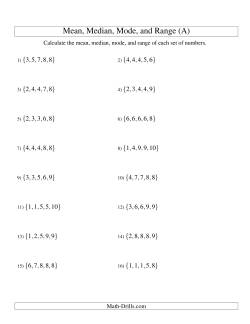
Calculating the mean, median, mode and range are staples of the upper elementary math curriculum. Here you will find worksheets for practicing the calculation of mean, median, mode and range. In case you're not familiar with these concepts, here is how to calculate each one. To calculate the mean, add all of the numbers in the set together and divide that sum by the number of numbers in the set. To calculate the median, first arrange the numbers in order, then locate the middle number. In sets where there are an even number of numbers, calculate the mean of the two middle numbers. To calculate the mode, look for numbers that repeat. If there is only one of each number, the set has no mode. If there are doubles of two different numbers and there are more numbers in the set, the set has two modes. If there are triples of three different numbers and there are more numbers in the set, the set has three modes, and so on. The range is calculated by subtracting the least number from the greatest number.
Note that all of the measures of central tendency are included on each page, but you don't need to assign them all if you aren't working on them all. If you're only working on mean, only assign students to calculate the mean.
In order to determine the median, it is necessary to have your numbers sorted. It is also helpful in determining the mode and range. To expedite the process, these first worksheets include the lists of numbers already sorted.
Normally, data does not come in a sorted list, so these worksheets are a little more realistic. To find some of the statistics, it will be easier for students to put the numbers in order first.
Collecting and Organizing Data

Teaching students how to collect and organize data enables them to develop skills that will enable them to study topics in statistics with more confidence and deeper understanding.
-
Construct Line Plots with Smaller Numbers and Lines with Ticks Provided (Small Data Set) Construct Line Plots with Smaller Numbers and Lines Only Provided (Small Data Set) Construct Line Plots with Smaller Numbers (Small Data Set) Construct Line Plots with Larger Numbers and Lines with Ticks Provided (Small Data Set) Construct Line Plots with Larger Numbers and Lines Only Provided (Small Data Set) Construct Line Plots with Larger Numbers (Small Data Set)
-
Construct Line Plots with Smaller Numbers and Lines with Ticks Provided Construct Line Plots with Smaller Numbers and Lines Only Provided Construct Line Plots with Smaller Numbers Construct Line Plots with Larger Numbers and Lines with Ticks Provided Construct Line Plots with Larger Numbers and Lines Only Provided Construct Line Plots with Larger Numbers
Interpreting and Analyzing Data
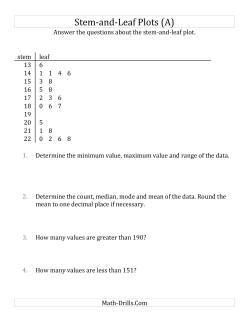
Answering questions about graphs and other data helps students build critical thinking skills. Standard questions include determining the minimum, maximum, range, count, median, mode, and mean.
Probability Worksheets
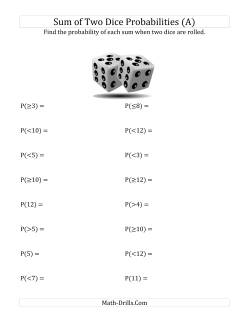
Spinners can be used for probability experiments or for theoretical probability. Students should intuitively know that a number that is more common on a spinner will come up more often. Spinning 100 or more times and tallying the results should get them close to the theoretical probability. The more sections there are, the more spins will be needed.
-
Number Spinner Probability (4 Sections) Number Spinner Probability (5 Sections) Number Spinner Probability (6 Sections) Number Spinner Probability (7 Sections) Number Spinner Probability (8 Sections) Number Spinner Probability (9 Sections) Number Spinner Probability (10 Sections) Number Spinner Probability (11 Sections) Number Spinner Probability (12 Sections)
Non-numerical spinners can be used for experimental or theoretical probability. There are basic questions on every version with a couple extra questions on the A and B versions. Teachers and students can make up other questions to ask and conduct experiments or calculate the theoretical probability. Print copies for everyone or display on an interactive white board.
-
Animal Spinner Probability (4 Sections) Animal Spinner Probability (5 Sections) Animal Spinner Probability (10 Sections) Letter Spinner Probability (4 Sections) Letter Spinner Probability (5 Sections) Letter Spinner Probability (10 Sections) Color Spinner Probability (4 Sections) Color Spinner Probability (5 Sections) Color Spinner Probability (10 Sections)
-
Animal/Letter Combined Spinner Probability (4 Sections) Animal/Letter Combined Spinner Probability (5 Sections) Animal/Letter Combined Spinner Probability (10 Sections) Animal/Letter/Color Combined Spinner Probability (4 Sections) Animal/Letter/Color Combined Spinner Probability (5 Sections) Animal/Letter/Color Combined Spinner Probability (10 Sections)
